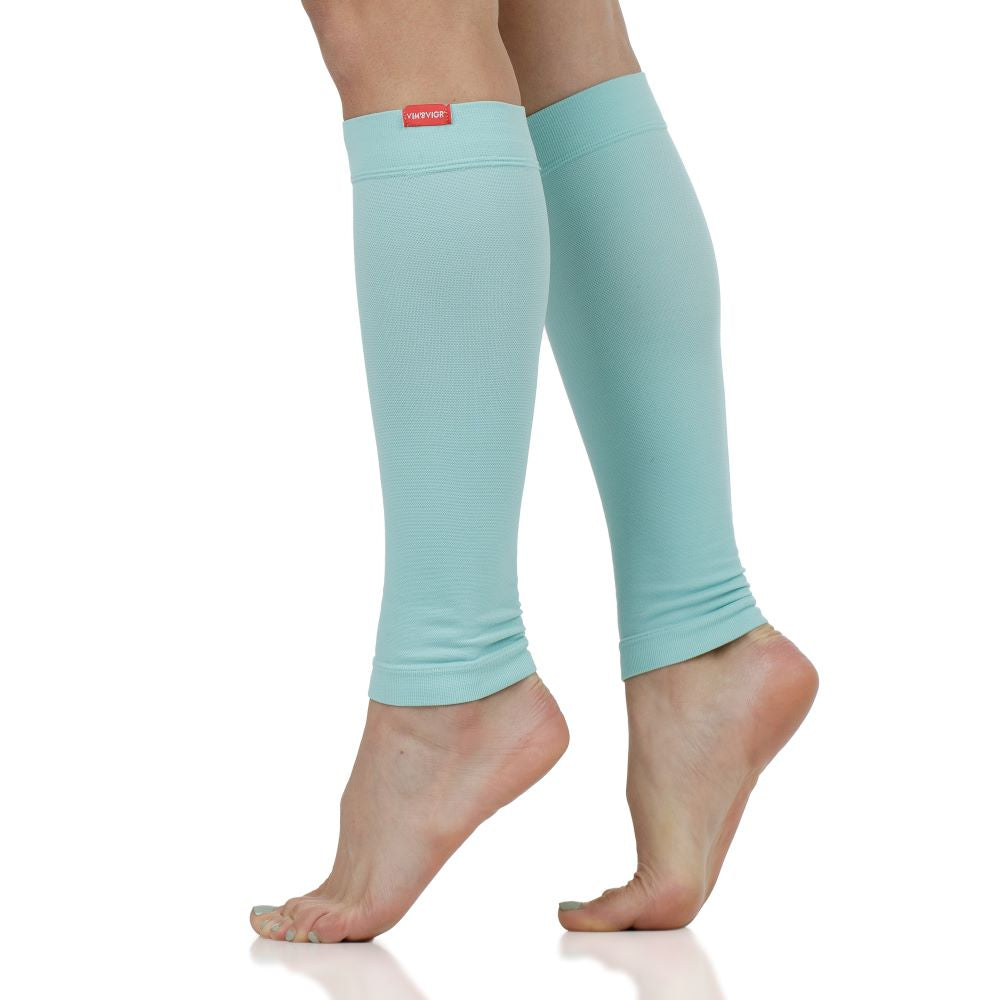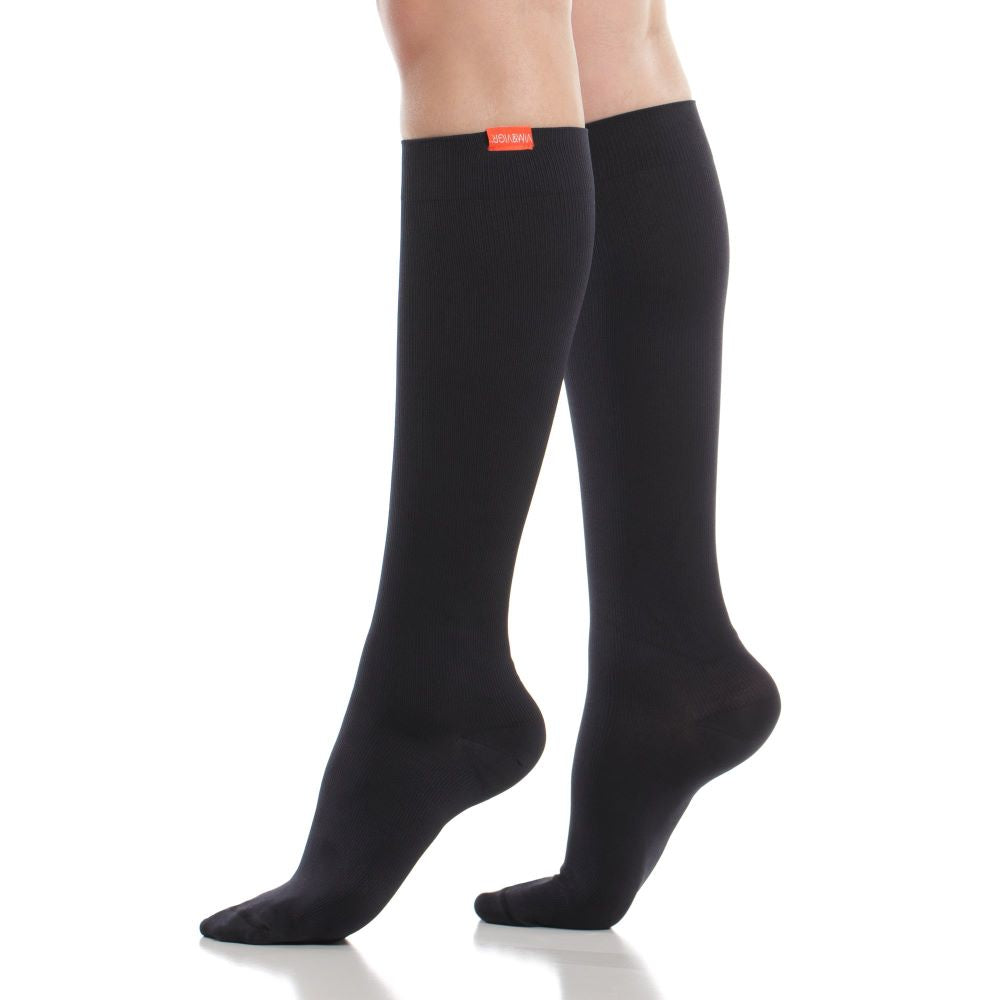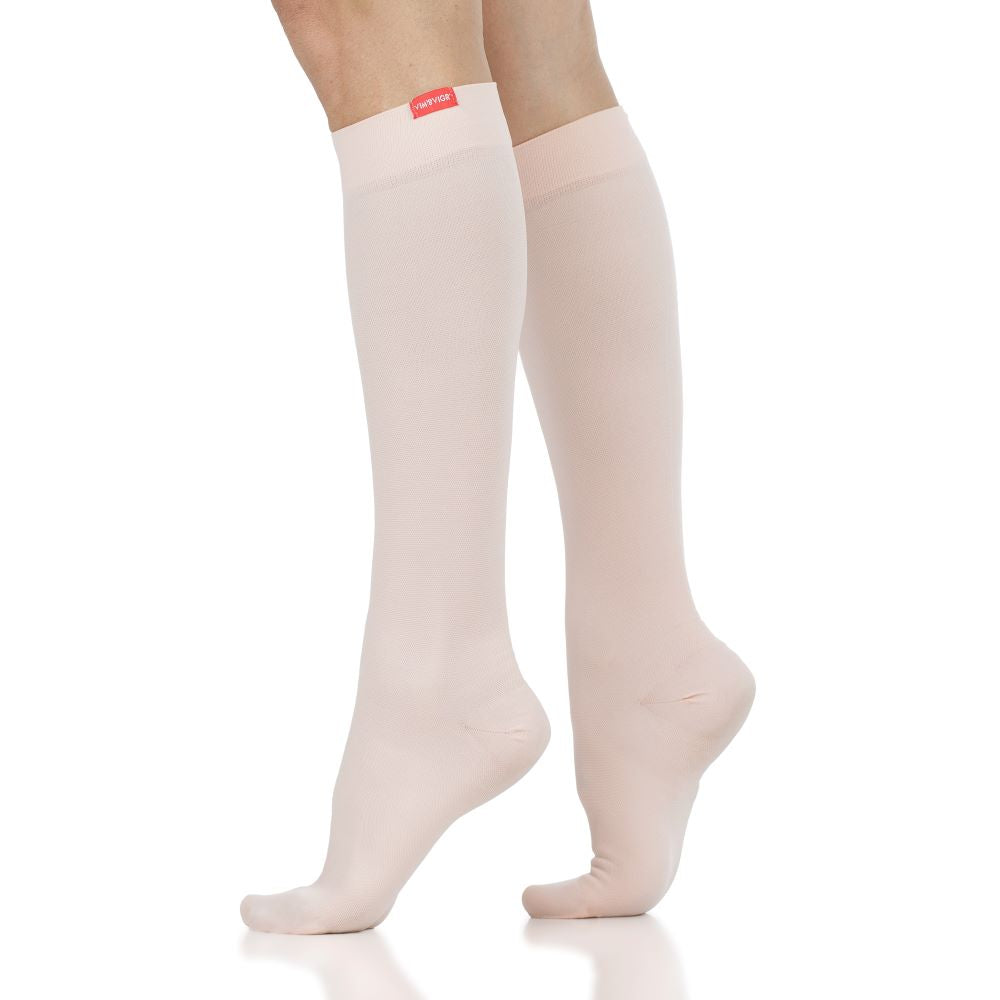Signs of Poor Circulation in Pregnancy & What to Do About It
Pregnancy is a challenging time for women of all ages and medical conditions or fitness levels. So many changes occur, and the hormonal changes during pregnancy can even cause changes to your circulatory system. One major change is the increase in blood flowing through your body, which might cause problems. Additionally, many women have trouble sleeping or finding comfortable positions to sit in at work, among other issues.
When is poor circulation a problem in pregnancy and what can you do to manage this? Healthy blood flow is always essential, but optimal health is even more important during this delicate period. With good attention to and management of your symptoms, you can optimize your circulation and become more comfortable and healthier during pregnancy.
In this article, we’ll look at signs that may point to circulation problems, their possible causes, and ways you can manage and reduce these symptoms safely.
Signs of Poor Circulation in Pregnancy
As blood volume increases and hormonal changes take effect during pregnancy, you may notice signs that point to potential problems. During pregnancy, poor circulation in the legs is experienced by most women. Here are the most common indicators that your circulatory system might be struggling.
Edema & Swelling
Poor circulation can have a negative effect on the body, leading to edema and swelling, particularly in the extremities. One scientific review reported that 8 out of 10 women may experience edema. When you’re pregnant, your body is working harder than ever to keep both you and your baby safe and healthy. You need more nutrients and fluids, and your body even increases the amount of water it holds from 6 to 8 liters. This along with the changes to your blood vessels can cause changes in blood flow, according to one scientific study. This can cause venous insufficiency during pregnancy. Specifically, this means that blood flows out from your heart, but cannot flow back as it normally should.
As a result, pregnant women often suffer from swollen ankles and feet. This can lead to severe pain or throbbing. The pain is caused by blood pooling at the lower extremities and not circulating back up towards the heart. It can be made worse by long periods of sitting, for example during travel or if you have a sedentary job.
Edema becomes more pronounced from 20 weeks through the third trimester of pregnancy and can create real discomfort, according to Penn Medicine. It is even more obvious when you sit or stand for longer periods of time without moving. To combat it, compression socks are a great help, as well as elevating your legs as often as you can.
If the swelling gets worse and becomes accompanied by pain, redness and heat, you should see a doctor as this could be a sign of deep vein thrombosis (DVT). DVT can develop because of blood clots and can be quite severe, so needs to be addressed immediately.

Numbness or Tingling
When circulation during pregnancy is less than optimal, your hands and feet can go numb or start to tingle. This is another sign that blood isn’t reaching the extremities as effectively as it should.
Cold Hands and Feet
Similarly, if you have poor circulation during pregnancy, your hands and feet tend to be cold even when it’s warm outside. Sitting or standing for long periods of time can cause cold feet, and a number of medical conditions are associated with cold extremities and poor circulation.
Warm up cold feet with merino wool compression socks.

Skin Discoloration
Normally, when we talk about the “pregnancy glow,” this is caused by an increase in blood volume and oil production during pregnancy, according to Johns Hopkins Medicine. Some people also experience an increase in melanin during pregnancy, leading to darker spots appearing on the body. However, skin discoloration or redness, especially on the hands and feet, is a sign of blood flow being impaired. It is important to note, though, that this can also be driven by hormonal changes - so you should check with a medical professional if this happens to you.
Muscle Cramps
One report found that up to 30% of women experience leg cramps during pregnancy. Different research studies have tried to find what causes muscle cramps during pregnancy, but the Mayo Clinic reports that the exact cause of leg cramps at this time is unclear. Scientists have hypothesized that the muscle cramps could be linked to low calcium levels, dehydration, or poor circulation during pregnancy.
Exhaustion
Feeling tired is common during pregnancy since your body has so much more work to do. But a change in blood flow can also lead to feelings of exhaustion at this time. Johns Hopkins Medicine stated that the exhaustion you feel might be caused by hormone changes and the blood flow to the placenta and fetus. They could be coupled with edema or dizziness or any other of the signs listed here, which indicates a connection to circulation problems. Discuss this with your doctor right away if you are experiencing it.
Dizziness
When blood flow is not normal, for example not enough is travelling to your brain, you could become dizzy. This is a sign of abnormal blood pressure regulation (since the heart isn’t pushing blood around fast enough for the oxygen to reach your brain).
Severe dizziness accompanied by headaches should be investigated by a medical team immediately. Mild symptoms point to the likelihood of poor circulation, so you can start looking into ways to improve your blood flow in that case.
What Causes Poor Circulation During Pregnancy?
Pregnancy triggers many changes in the body, from hormone levels to a significant increase in blood volume and pressure on the internal organs. These all have connections to changes in circulation, which could cause problems for both mother and the baby.
Hormonal Changes
Pregnant women have a mix of hormones in their body. This can affect blood pressure, triggering circulatory problems. Hormones like estrogen and relaxing contribute to the dilation or relaxation of blood vessels, which increases blood flow to the kidneys, for example. It could lead to low blood pressure, especially in the second and third trimesters according to one report.
Increased Blood Volume
During pregnancy, as the baby grows, the heart needs to pump more and more blood to support baby’s growth and development. This means that your body will begin to retain more fluids and lead to more blood volume in your body. Cardiac output (the volume of blood pumped out of your heart over one minute) can increase by 30 to 50% for pregnant women. And, as this cardiac output increases, your resting heart rate also increases, from an average of 70 beats per minute before pregnancy to nearly90 beats per minute, according to one study.
This could cause increases in blood pressure and make vascular problems, like existing varicose veins (for example), worse. If vascular problems worsen you may run into painful edema and possibly other more serious conditions.
Weight Gain
Putting on excessive weight, sometimes triggered by eating an unhealthy diet, can negatively affect blood flow during pregnancy. Focusing on eating good amounts of whole foods (such as fruits and vegetables) and including exercise in your daily routine can help with this.
Walk confidently with compression socks during pregnancy

Pressure from the Growing Fetus
As the baby grows during pregnancy, it puts added pressure on the body, specifically the circulatory system. The heart needs to pump more blood to support the uterus. Additionally, changes in hormone levels signal your body to change to the volume of fluid being transported by your circulatory system. This might contribute to poor circulation.
Pre-Existing Risk Factors
There are several pre-existing risk factors that may lead to poor blood flow during pregnancy. People with high blood pressure, for example, might other problems like pre-eclampsia and even restricted fetal growth. Even if you haven’t monitored your blood pressure before becoming pregnant, checking for hypertension with your doctor is good practice so you can control this.
Risks of Poor Circulation in Pregnancy
In addition to the obvious discomfort of swelling or painful feet and ankles, poor blood flow can present some extended risks for both mother and baby. Here are some you should be aware of.
Risks for Mother
If blood flow is impaired during the pregnancy, women can develop blood clots or more advanced problems like deep vein thrombosis. Blood vessels can be damaged, leading to the formation of varicose veins. Some women can suffer from a rare condition called pre-eclampsia, which can affect all your organs.
Risks for Baby
Inadequate blood flow will impair the development of the fetus during pregnancy. This is primarily because blood transports oxygen and nutrients throughout the body, and implicitly to the fetus, helping it grow.
An extreme consequence of circulatory problems is fetal growth restriction - where the fetus is smaller than expected for the number of weeks of pregnancy. Poor circulation during pregnancy affects the growth of organs, tissues, and cells of the fetus to lead to long-term problems. Pre-eclampsia and fetal growth restriction are connected, and associated with low volume circulation, as shown in various studies.
Managing Poor Circulation In Pregnancy
Many cases of poor circulation in pregnancy can be managed through lifestyle changes. You may find that you need to wear compression socks to bed to keep feet from tingling or becoming cold. Walks and gentle exercise can stimulate blood flow and keep you energized throughout the day. Here are some other tips you can find useful.
Wear Compression Socks
Graduated compression socks stimulate upwards circulation, reducing the risk of blood and lymph fluid pooling around your ankles. They have been proven to also provide protection from blood clots, varicose veins, and other peripheral circulation issues.
Compression socks are also good for protecting and supporting the joints and lower leg muscles as there is increasing pressure from the body. They have a tight grip on the lower legs, which is reassuring and reduces the impact of landing on hard surfaces when walking.
Finally, compression garments support you gently and without too much impact on your everyday life. You can wear them for as long as you feel comfortable, whenever, and even when sleeping, for a gentle but effective stimulant on your circulation.
Walk Daily
Physical activity is very important during pregnancy, even as things slow down and exercise might feel difficult. Make time for something every day, whether it’s a low-intensity workout or a walk outside. The key is to keep the body moving, which in turn will help you keep healthy blood circulation during pregnancy. Additionally, don’t spend too long sitting down. Take regular breaks to stretch your legs and move around, especially when travelling.
Prioritize a Healthy Diet & Hydration
Watching what you eat is always important, and even more so when you are pregnancy. Ensure you eat a variety of healthy foods, which will help you get all the required nutrients, vitamins, and minerals that you and your baby need. For best impacts on the blood circulation, ensure you have three servings of iron-rich foods per day, which will help keep healthy red blood cells.
Additionally, poor hydration levels can increase your chances of cramping - so ensure you drink plenty of water.
Put Your Feet Up
Elevating your feet helps the blood travel from the legs to and may help prevent the formation of blood clots and varicose veins. Uncross your legs when sitting or lying down, too. All of this will help prevent swelling.
Rest Often
Ultimately, comfort is key when you’re pregnant. As the growing baby puts more pressure on the circulatory system, the lower extremities feel it first. Putting your feet up, lying down, stretching gently, and avoiding spending too long in one position are all ways to be gentle with your body and support your circulatory system.
When to Call Your Doctor
Poor circulation when pregnant is a common side-effect, especially as the baby grows and the increase in weight becomes harder to manage. It is important to keep an eye out for unusual symptoms and discuss these with your doctor right away. You should monitor your blood pressure regularly during check-ups. If you gain more weight very suddenly, if symptoms like numb or tingling feet increase in severity and frequency, or if anything feels out of the ordinary, it’s safer to refer to a medical professional rather than take any risks.
References
Davison J. M. (1997). Edema in pregnancy. Kidney international. Supplement, 59, S90–S96. Read it here.
Gimunová, M., Zvonař, M., Kolářová, K., Janík, Z., Mikeska, O., Musil, R., Ventruba, P., & Šagat, P. (2017). Changes in lower extremity blood flow during advancing phases of pregnancy and the effects of special footwear. Jornal vascular brasileiro, 16(3), 214–219. Read it here.
Marnach M. (2023). Tips to avoid leg cramps during pregnancy. Mayo Clinic. Read it here.
Hensley J. G. (2009). Leg cramps and restless legs syndrome during pregnancy. Journal of midwifery & women's health, 54(3), 211–218. Read it here.
Massinde, A., Ntubika, S., & Magoma, M. (2011). Extensive hyperpigmentation during pregnancy: a case report. Journal of medical case reports, 5, 464. Read it here.
(2019). First Trimester Fatigue. Johns Hopkins Medicine Health. Read it here.
Kristiansson, P., & Wang, J. X. (2001). Reproductive hormones and blood pressure during pregnancy. Human reproduction (Oxford, England), 16(1), 13–17. Read it here.
Bossung, V., Singer, A., Ratz, T., Rothenbühler, M., Leeners, B., & Kimmich, N. (2023). Changes in Heart Rate, Heart Rate Variability, Breathing Rate, and Skin Temperature throughout Pregnancy and the Impact of Emotions-A Longitudinal Evaluation Using a Sensor Bracelet. Sensors (Basel, Switzerland), 23(14), 6620. Read it here.
Lu, Y., Chen, R., Cai, J., Huang, Z., & Yuan, H. (2018). The management of hypertension in women planning for pregnancy. British medical bulletin, 128(1), 75–84. Read it here.
Gyselaers, W., & Lees, C. (2022). Maternal Low Volume Circulation Relates to Normotensive and Preeclamptic Fetal Growth Restriction. Frontiers in medicine, 9, 902634. Read it here

















Leave a comment